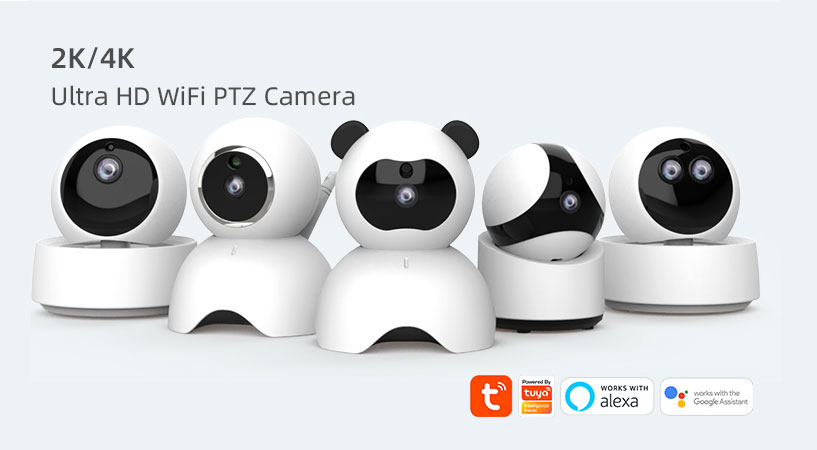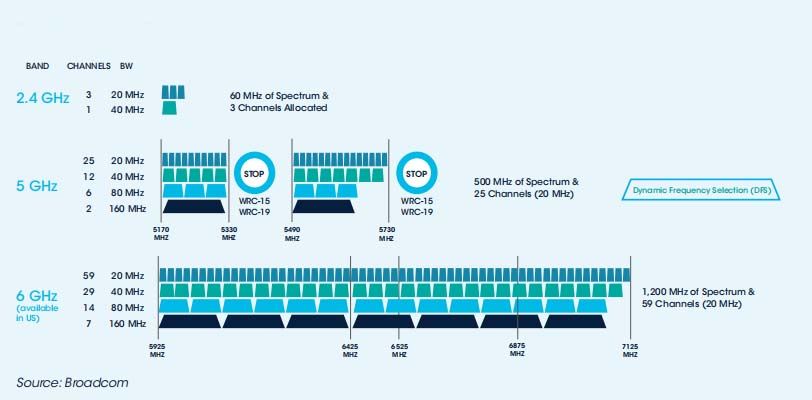
Tuya 5G Wi-Fi Security Camera
Today we are discussing the Wi-Fi technology in video surveillance industry. Nowadays we are using dual-band Wi-Fi routers for home or office. Dual band Wi-Fi routers support 2.4G and 5G frequency Wi-Fi. It’s so weird that most security cameras even some latest design Tuya smart cameras do not support 5G. Intending to know this reason, we may need to know the Wi-Fi standard.
Wi-Fi technology & standard
Wi-Fi is based on IEEE802.11 standard wireless local network technology. IEEE802.11 is a kind of network standard, the standard get updated during the course of time or the development of technology.
| Year | Name | IEEE Standard | Remarks |
| 1997 | 802.11 | 2.4GHz, max. 2Mbit/s | |
| 1999 | Wi-Fi 1 | 802.11b | 2.4GHz, max. 11Mbit/s |
| 1999 | Wi-Fi 2 | 802.11a | 5GHz, max. 54Mbit/s |
| 2003 | Wi-Fi 3 | 802.11g | 2.4GHz, max. 54Mbit/s |
| 2009 | Wi-Fi 4 | 802.11n | 2.4/5GHz, max. 600Mbit/s |
| 2014 | Wi-Fi 5 | 802.11n | 5GHz, max. 6.9Gbit/s |
| 2020 | Wi-Fi 6 | 802.11ax | 2.4/5GHz, max. 9.6Gbit/s (6e supports 6GHz) |
| Wi-Fi 7 | 802.11be | 2.4/5/6GHz, 30Gbit/s |
From above chart we know that Wi-Fi frequency has extended from original 2.4GHz to nowadays 5GHz and 6GHz, the maximum bandwidth/speed keeps climbing from Mbit/s to Gbit/s, the development is very fast, however new standard always can downwardly support old standard. At present, Wi-Fi 6 becomes a mature technology, there are many network products support this new standard, at the same time Wi-Fi 7 standard is under the development.
Unlike consumer products such as smartphone, tablets, computers, the video surveillance industry is not sensitive to new Wi-Fi technology, the benefits of utilizing new Wi-Fi technology/standard hardly bring extra value for security cameras. Utilizing the new Wi-Fi standard will increase the product cost. For example, a 2-megapixel 1080p Wi-Fi camera may sell at 30 dollars, if upgrading the camera’s Wi-Fi module to support 5G, this will add extra 5 dollar per set. This is detrimental to competitiveness of manufacturers in price sensitive market.
Advantages of 5G Wi-Fi
As the new technology and new frequency, comparing to 2.4GHz, 5GHz Wi-Fi transmission brings much development and many improvements. 5GHz supports more bandwidth, can be divided into more signal channels. Comparing to 2.4GHz, 5GHz has advantages: less interference (a lot of devices use 2.4GHz frequency such as microwave oven, wireless mouse, Bluetooth, will cause interference), transmitting speed is much faster, connection is more stable.

Disadvantages of 5G Wi-Fi
- Short transmission distance: higher frequency, shorter wavelength, transmitting distance shorter. 5GHz frequency is higher and its wavelength is shorter. While 2.4GHz frequency is low and wavelength is long.
- Weak wall penetrating performance: with obstacles, 2.4G Wi-Fi can transmit longer distance than 5GHz.
- Higher hardware requirement: higher bandwidth and faster speed requires the hardware to handle enormous data, therefore having a higher requirement on chips.
5G Wi-Fi Security Cameras
Considering all the pros and cons of the 5GHz, we can conclude that 5GHz Wi-Fi can not bring much benefits for products in video surveillance industry. Presently, consumer security cameras support 1080p 2-megapixel resolution, max. support 5-megapixel, the corresponding network bandwidth/speed required is 2Mbit/s-5Mbit/s. Conventional 2.4G Wi-Fi can adequately meet this requirement. Consumer security cameras usually connects to Internet, users are able to watch video through app, video is stored on internal memory card. Users will not watch the live stream 24 hourly, therefore there is not much high requirement on stability and reliability for the network connection.
The disadvantages of 5G Wi-Fi will severely impact the function of the security cameras. As we have mentioned, the upgrading will add extra cost for each set. Additionally, the transmission distance of 5G is shorter than 2.4G, and weak signal penetrating capability, all these will impact the user experience. All these reasons result to there are few security cameras support 5G Wi-Fi. A few camera can support 5G such as EZVIZ C6P 3-megapixel camera supports IEEE802.11a/b/n/ac, Ring Floodlight cam pro supports 802.11 b/g/n/ac, Arlo ultra 2 camera supports 802.11 b/g/n/ac, Google nest camera supports 802.11 a/b/g/n/ac.
All these cameras can support 5G, but price is very high. Normally. If the security camera only supports 2.4G, its Wi-Fi/wireless specification is 802.11 b/g/n. If the wireless specification is 802.11 a or 802.11ac, then it must support 5GHz Wi-Fi.